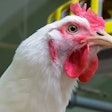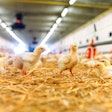
Across Europe, the usual seasonal fall in outbreaks of highly pathogenic avian influenza (HPAI) in poultry has occurred with the coming of summer.
However, there have been further cases at one location in each of England, France and Sweden. Meanwhile, further cases in wild birds continue to be reported widely across the continent.
Of the European Union states, only Sweden has officially registered new cases of HPAI in commercial poultry over the past three weeks. This is according to the latest notifications to the World Organisation for Animal Health (WOAH).
In the last week of June, presence of the HPAI virus of the H5N1 serotype was confirmed in a flock of 1,900 laying hens after 120 of the birds died. The affected premises was a farm on Gotland, Sweden’s largest island in the Baltic Sea. The virus was last detected there at the end of March, and source of the latest infection is unknown.
In France, one further outbreak in poultry has been confirmed by the agriculture ministry. The outbreak occurred in Pas-de-Calais, a department in the northern region of Hauts-de-France.
This brings the total outbreaks among poultry flocks on the French mainland since August of last year to 400. So far, all of these outbreaks have been linked to the H5N1 virus variant.
In France, the latest HPAI outbreak wave that has resulted in the culling of 10 million poultry has ended, according to Reuters. Citing sources in the farm ministry, the report also confirms the government’s commitment to launch a vaccination program in the coming months to control HPAI in poultry.
Based on information reported to WOAH, almost 21.6 million commercial poultry in France have been directly impacted by HPAI since November of 2021, including 21.5 million birds culled.
Overview of HPAI in European poultry
Since the start of this year, 375 outbreaks of HPAI in poultry have been confirmed in 20 European Union (EU) member states and neighboring countries. This is according to the Animal Disease Information System by the European Commission (EC; as of June 23). The figure includes two outbreaks in Turkey (Tűrkiye), and remains unchanged from the previous update, which was dated June 17.
For comparison, 24 nations registered a total of 2,321 outbreaks in poultry through this system during 2022.
Of the total, the country with the most outbreaks — now with 149 — is France. Next come Hungary (79 outbreaks to date), Poland (59), and the Czech Republic (Czechia) and Germany, each with 24 outbreaks in the year to date.
Over the past three weeks, the veterinary authorities of Poland and Slovakia have declared to WOAH that the HPAI situation in poultry has been “resolved” across their respective territories.
Avian flu restrictions lifted further in Great Britain
In England, Wales, and Scotland, the risk of avian influenza for all poultry has been reduced to “low,” according to the agriculture department, Defra.
As a result in this revised assessment, the Avian Influenza Prevention Zones (AIPZ) in England, Scotland, and Wales were lifted from July 4.
However, the “low” risk applies only to poultry and captive birds. In contrast, the risk of infection in wild birds remains “high,” Defra says. So while the ban on shows, fairs and markets involving poultry continue to be banned, all bird keepers are reminded of the need to maintain biosecurity measures, and to be alert for signs of disease.
Furthermore, mandatory restrictions continue in those areas surrounding HPAI-infected premises.
The EC system does not include information on the disease situation in the United Kingdom (U.K.; except Northern Ireland).
Over the past week, presence of the H5N1 serotype of the HPAI virus has been confirmed on a commercial poultry unit in the Cumbria region in northwestern England.
Three European nations report further cases in captive birds
So far in 2023, 13 countries have together registered a total of 86 outbreaks of HPAI in captive birds through the EC’s system (as of June 23). This total — covering backyard poultry, zoos and similar premises — has not changed since the previous update.
Recording the most outbreaks in captive birds have been Germany and France, now each with a total of 29 for the year, followed by Belgium with 11. Each of the other 10 nations in the regions has registered between and four outbreaks in this category.
In mid-June, one further outbreak linked to the H5N1 virus was reported to WOAH by the authorities in France. Affected was a flock of 50 captive birds in Gers, a department in the southern region of Occitania.
Poland has recently confirmed the country’s first HPAI outbreak in poultry for more than one month. Presence of the H5N1 HPAI virus was detected in a non-commercial flock of 116 birds in the southern province of Lesser Poland, according to the national chief veterinary office.
Two further outbreaks have been recorded in captive birds in the U.K. Affected were two eagles at a wildlife conservation center in Scotland, and captive birds of unknown type and number in the southern English county of West Sussex.
Following five previously confirmed outbreaks in backyard flocks, the HPAI situation in Slovakian backyard poultry is declared “resolved” to WOAH.
Continued outbreaks among wild birds
With the summer months, there has been little sign of a decline in HPAI cases in wild birds, as has been observed in previous years. Across the continent, majority of infections have been detected in seabirds, particularly seagulls of various species.
Up to June 23, the EC’s System had recorded 2,680 outbreaks across 27 states of the EU and its neighbors. This is an increase of 129 since the previous update dated June 17.
Worst affected have been Germany (880 outbreaks for the year to date), France (354), the Netherlands (290), Italy (174), and Belgium (162).
For each of these countries, the total for each of these nations has risen since the EC’s report one week previously.
Also registering more cases over this period were Denmark, Finland, Hungary, the Irish Republic, Latvia, Lithuania, Northern Ireland, Norway, Poland, Spain, and Sweden.
For comparison, 33 nations registered a total of 3,245 outbreaks in wild birds with the EC’s system during 2022.
As well as H5N1, wild birds recently found dead in Norway have tested positive for the H5N5 virus variant and an H5 virus, according to WOAH notifications.
Furthermore, the animal health agencies of Estonia, Russia, and the U.K. have reported to WOAH further cases in their respective wild bird populations.
View our continuing coverage of the global avian influenza situation.












